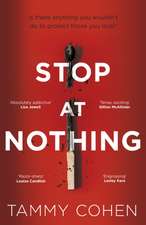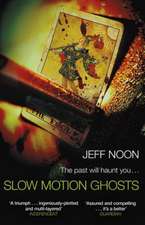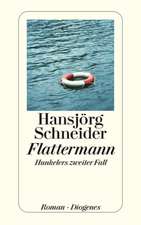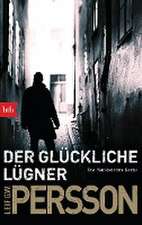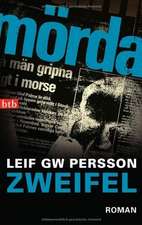Another Time, Another Life: The Story of a Crime
Autor Leif GW Persson Traducere de Paul Norlenen Limba Engleză Paperback – oct 2012
Preț: 89.66 lei
Nou
Puncte Express: 134
Preț estimativ în valută:
17.16€ • 17.69$ • 14.49£
17.16€ • 17.69$ • 14.49£
Carte indisponibilă temporar
Doresc să fiu notificat când acest titlu va fi disponibil:
Se trimite...
Preluare comenzi: 021 569.72.76
Specificații
ISBN-13: 9780307390219
ISBN-10: 0307390217
Pagini: 404
Dimensiuni: 134 x 203 x 22 mm
Greutate: 0.31 kg
Editura: VINTAGE BOOKS
ISBN-10: 0307390217
Pagini: 404
Dimensiuni: 134 x 203 x 22 mm
Greutate: 0.31 kg
Editura: VINTAGE BOOKS
Notă biografică
Leif GW Persson has chronicled the political and social development of modern Swedish society in his awardwinning novels for more than three decades. Persson has served as an adviser to the Swedish Ministry of Justice and is Sweden’s most renowned psychological profiler. He is a professor at Sweden’s National Police Board and is considered the country’s foremost expert on crime. He lives in Stockholm.
Extras
I
On Thursday the twenty-fourth of April 1975, death came during office hours, and oddly enough in both female and male form. Which is not to say the men weren’t still in the majority. Death was attractively and neatly dressed, and to start with behaved both courteously and urbanely. Nor was it by chance that the ambassador was at his place of employment, which was otherwise far from always the case. On the contrary, this was the result of careful planning, and key to the whole affair.
The embassy of the Federal Republic of Germany in Sweden is located on Djurgården in central Stockholm, and has been since the early 1960s. In the northeast corner of the area that goes by the name Diplomat City, with the Swedish Radio and TV building and the Norwegian embassy as its closest neighbors, it hardly gets finer than that as Stockholm addresses go. There is nothing remarkable, however, about the embassy building itself. An ordinary, dreary concrete box in the sixties’ functional style, three stories and just over twenty thousand square feet of office space with entry on the ground floor at the north end, it is far from the most prestigious foreign posting in the German Ministry of Foreign Affairs.
The weather was nothing to write home about that day when death came to call. It was a typical Swedish spring with biting winds, restless clouds under a pewter-colored sky, and only a vague promise of better, warmer times. For death these were ideal conditions. Best of all security at the embassy was almost nonexistent; it was a building that was easy to occupy and defend but difficult to storm. Best of all, a solitary, rather worn-out attendant manned the reception area where, if worse came to worst, the glass doors of the security passage could be forced manually. Granted, the weather conditions would not help the perpetrators when it was time to leave.
At some point between quarter past eleven and eleven-thirty in the morning things started to happen, and the fact that a more precise point in time could not be established was also owing to the poor security. Whatever. Within the course of a few minutes, six visitors arrived in three groups of two people each, young people between twenty and thirty, all German citizens of course, and they all wanted help with various matters.
In their homeland they were notorious. Their likenesses and descriptions were on thousands of wanted posters all across West Germany. Their faces were also to be found in airports, train and bus stations, banks, post offices, and basically any public area where there was vacant wall space available. Their images were even on file at the embassy in Stockholm, in a folder in a desk drawer in the reception area, however useful that might be. But when they actually showed up no one recognized them, and the names by which a few of them introduced themselves were different from their own.
First two young men arrived who wanted advice on an inheritance issue that concerned both Swedish and German jurisdictions, and it was clear, if for no other reason than the bulging briefcase one of them was lugging, that this was no simple matter. The guard in the reception area told the two men where they could find the official they needed and let them into the embassy.
Immediately after this came a young couple who wanted to renew their passports. A routine errand, one of the most common at the embassy. The young woman gave a friendly smile to the guard as he opened the door for her and her companion.
But then things became more complicated. Two young men showed up looking to acquire work permits. The guard explained that this was not an embassy matter but rather a question for the Swedish authorities. Instead of listening to him the two persisted. One of them even got a bit stubborn when the guard didn’t want to let them in. While they stood there arguing, one of the embassy employees, who was going out for lunch, appeared. As he exited, they both took the opportunity to slip in and immediately disappeared up the stairway to the upper floors, without taking any notice of the guard shouting at them to come back. Then everything happened very fast. The six congregated in the stairwell outside the consular department on the second floor, pulled on balaclavas, and took out pistols, submachine guns, and hand grenades. After that they cleared the offices of superfluous visitors and personnel; a few introductory rounds in the ceiling making the plaster spray was sufficient for the majority of the staff to flee head over heels out onto the street, and the twelve who remained behind were gathered together and herded into the library on the top floor, with military precision and without wasting time on any pleasantries whatsoever.
At eleven forty-seven the first alarm about “gunfire at the West German embassy” came to the Stockholm police command center, and this unleashed an all-out response. Uniformed police, detectives from the central detective squad, the homicide squad, and the secret police, in effect all personnel that could be called out were ordered there; blue lights, sirens, and screeching tires all headed for the West German embassy on Djurgården, and the alarm they are responding to is already clear enough. The West German embassy has been occupied by terrorists. They are armed and dangerous. All police are urged to observe the greatest possible caution.
First on the scene was a radio car from Östermalm precinct, and that it arrived at eleven forty-six according to the submitted report was not because the patrol commander was psychic; his watch was two minutes slow when he noted the time, and considering what happened later this was a minor error.
By twelve-thirty, after a little more than forty minutes, the police had already surrounded the embassy, secured the basement and lower floors inside the building, set up barricades in the area outside the embassy to hold back the quickly growing crowds of journalists and curiosity seekers, set up a temporary command center, and begun to organize their radio and telephone connections to police headquarters, the embassy, and the government offices. The head of the homicide squad who would be leading the effort was on the scene, and as far as he and his colleagues were concerned they were ready to get going.
The six people inside the embassy hadn’t been twiddling their thumbs either. They had led the twelve employees being held hostage, including the ambassador himself, from the library to the ambassador’s office in the southwest corner of the top floor of the building, and as far away from the entry as they could get. A few of the female employees had to help by filling wastebaskets with water and stopping up the sinks and toilets with paper towels to prevent an expected gas attack via the water pipes. Two of the terrorists primed blasting caps at strategic places on the top floor while the others guarded the hostages and the door toward the stairwell. And after all that they were ready at approximately the same time as their opponent.
The terrorists made the first move, opening with a simple, unambiguous demand. If the police did not immediately leave the embassy building, one of the hostages would be shot. The head of the homicide squad was not a man to get worked up unnecessarily, and his self-confidence was great, if not unlimited. Besides, he had been present at the drama on Norrmalmstorg a year and a half before, and there he had learned that if the culprits only had time to get to know their hostages, then the strangest feelings of camaraderie could arise between them, and the risk of violence would be greatly reduced. This interesting human mechanism had even been given a special name, “Stockholm syndrome,” and in the general psychological delirium no one gave any thought to the limited extent of its empirical basis.
Therefore the head of homicide thought he was on a solid behavioristic footing when he sent word that he had made note of the terrorists’ wishes and was willing to talk things over. But his adversaries had different, more violent ideas. After only a few minutes a volley of shots echoed from the top floor of the embassy. Then the door to the upper corridor opened and the German military attaché’s bloody, lifeless body was thrown out down the stairs, coming to rest on the halfway landing. That done, the terrorists again made contact.
On Thursday the twenty-fourth of April 1975, death came during office hours, and oddly enough in both female and male form. Which is not to say the men weren’t still in the majority. Death was attractively and neatly dressed, and to start with behaved both courteously and urbanely. Nor was it by chance that the ambassador was at his place of employment, which was otherwise far from always the case. On the contrary, this was the result of careful planning, and key to the whole affair.
The embassy of the Federal Republic of Germany in Sweden is located on Djurgården in central Stockholm, and has been since the early 1960s. In the northeast corner of the area that goes by the name Diplomat City, with the Swedish Radio and TV building and the Norwegian embassy as its closest neighbors, it hardly gets finer than that as Stockholm addresses go. There is nothing remarkable, however, about the embassy building itself. An ordinary, dreary concrete box in the sixties’ functional style, three stories and just over twenty thousand square feet of office space with entry on the ground floor at the north end, it is far from the most prestigious foreign posting in the German Ministry of Foreign Affairs.
The weather was nothing to write home about that day when death came to call. It was a typical Swedish spring with biting winds, restless clouds under a pewter-colored sky, and only a vague promise of better, warmer times. For death these were ideal conditions. Best of all security at the embassy was almost nonexistent; it was a building that was easy to occupy and defend but difficult to storm. Best of all, a solitary, rather worn-out attendant manned the reception area where, if worse came to worst, the glass doors of the security passage could be forced manually. Granted, the weather conditions would not help the perpetrators when it was time to leave.
At some point between quarter past eleven and eleven-thirty in the morning things started to happen, and the fact that a more precise point in time could not be established was also owing to the poor security. Whatever. Within the course of a few minutes, six visitors arrived in three groups of two people each, young people between twenty and thirty, all German citizens of course, and they all wanted help with various matters.
In their homeland they were notorious. Their likenesses and descriptions were on thousands of wanted posters all across West Germany. Their faces were also to be found in airports, train and bus stations, banks, post offices, and basically any public area where there was vacant wall space available. Their images were even on file at the embassy in Stockholm, in a folder in a desk drawer in the reception area, however useful that might be. But when they actually showed up no one recognized them, and the names by which a few of them introduced themselves were different from their own.
First two young men arrived who wanted advice on an inheritance issue that concerned both Swedish and German jurisdictions, and it was clear, if for no other reason than the bulging briefcase one of them was lugging, that this was no simple matter. The guard in the reception area told the two men where they could find the official they needed and let them into the embassy.
Immediately after this came a young couple who wanted to renew their passports. A routine errand, one of the most common at the embassy. The young woman gave a friendly smile to the guard as he opened the door for her and her companion.
But then things became more complicated. Two young men showed up looking to acquire work permits. The guard explained that this was not an embassy matter but rather a question for the Swedish authorities. Instead of listening to him the two persisted. One of them even got a bit stubborn when the guard didn’t want to let them in. While they stood there arguing, one of the embassy employees, who was going out for lunch, appeared. As he exited, they both took the opportunity to slip in and immediately disappeared up the stairway to the upper floors, without taking any notice of the guard shouting at them to come back. Then everything happened very fast. The six congregated in the stairwell outside the consular department on the second floor, pulled on balaclavas, and took out pistols, submachine guns, and hand grenades. After that they cleared the offices of superfluous visitors and personnel; a few introductory rounds in the ceiling making the plaster spray was sufficient for the majority of the staff to flee head over heels out onto the street, and the twelve who remained behind were gathered together and herded into the library on the top floor, with military precision and without wasting time on any pleasantries whatsoever.
At eleven forty-seven the first alarm about “gunfire at the West German embassy” came to the Stockholm police command center, and this unleashed an all-out response. Uniformed police, detectives from the central detective squad, the homicide squad, and the secret police, in effect all personnel that could be called out were ordered there; blue lights, sirens, and screeching tires all headed for the West German embassy on Djurgården, and the alarm they are responding to is already clear enough. The West German embassy has been occupied by terrorists. They are armed and dangerous. All police are urged to observe the greatest possible caution.
First on the scene was a radio car from Östermalm precinct, and that it arrived at eleven forty-six according to the submitted report was not because the patrol commander was psychic; his watch was two minutes slow when he noted the time, and considering what happened later this was a minor error.
By twelve-thirty, after a little more than forty minutes, the police had already surrounded the embassy, secured the basement and lower floors inside the building, set up barricades in the area outside the embassy to hold back the quickly growing crowds of journalists and curiosity seekers, set up a temporary command center, and begun to organize their radio and telephone connections to police headquarters, the embassy, and the government offices. The head of the homicide squad who would be leading the effort was on the scene, and as far as he and his colleagues were concerned they were ready to get going.
The six people inside the embassy hadn’t been twiddling their thumbs either. They had led the twelve employees being held hostage, including the ambassador himself, from the library to the ambassador’s office in the southwest corner of the top floor of the building, and as far away from the entry as they could get. A few of the female employees had to help by filling wastebaskets with water and stopping up the sinks and toilets with paper towels to prevent an expected gas attack via the water pipes. Two of the terrorists primed blasting caps at strategic places on the top floor while the others guarded the hostages and the door toward the stairwell. And after all that they were ready at approximately the same time as their opponent.
The terrorists made the first move, opening with a simple, unambiguous demand. If the police did not immediately leave the embassy building, one of the hostages would be shot. The head of the homicide squad was not a man to get worked up unnecessarily, and his self-confidence was great, if not unlimited. Besides, he had been present at the drama on Norrmalmstorg a year and a half before, and there he had learned that if the culprits only had time to get to know their hostages, then the strangest feelings of camaraderie could arise between them, and the risk of violence would be greatly reduced. This interesting human mechanism had even been given a special name, “Stockholm syndrome,” and in the general psychological delirium no one gave any thought to the limited extent of its empirical basis.
Therefore the head of homicide thought he was on a solid behavioristic footing when he sent word that he had made note of the terrorists’ wishes and was willing to talk things over. But his adversaries had different, more violent ideas. After only a few minutes a volley of shots echoed from the top floor of the embassy. Then the door to the upper corridor opened and the German military attaché’s bloody, lifeless body was thrown out down the stairs, coming to rest on the halfway landing. That done, the terrorists again made contact.
Recenzii
“May be just what fans of Jo Nesbo and Stieg Larsson are looking for.”
—Booklist
“A dark, politically charged thriller . . . Red herrings—perhaps better, Red Brigades Herrings—ensue, as Persson unfolds a carefully plotted story . . . A practiced, Larsson-worthy procedural.”
—Kirkus
“Exceptional . . . Persson writes with a sure hand and sharp insight. His detectives are human, interesting, and fallible . . . Another winner from Persson. If anything, it’s even better than the first book. Fans of Scandinavian crime fiction will eat it up.”
—Library Journal
“While the documentary-style narrative is a bit of a departure from what Scandinavian crime fans have come to expect, it works quite well here (better than in Between Summer’s Longing and Winter’s End). In fact, this may be just what fans of Jo Nesbo and Stieg Larsson are looking for.”
—Booklist (starred review)
“An astonishing novel. Once again, Persson has written a masterpiece of a crime novel. Spectacular and thrilling, arrogant and titillating, entertaining and well written.”
—Västerviks-Tidningen
“A whopper of a thriller.”
—Jyllands-Posten
“A masterly political thriller that plays in a league of its own.”
—Aftonbladet
—Booklist
“A dark, politically charged thriller . . . Red herrings—perhaps better, Red Brigades Herrings—ensue, as Persson unfolds a carefully plotted story . . . A practiced, Larsson-worthy procedural.”
—Kirkus
“Exceptional . . . Persson writes with a sure hand and sharp insight. His detectives are human, interesting, and fallible . . . Another winner from Persson. If anything, it’s even better than the first book. Fans of Scandinavian crime fiction will eat it up.”
—Library Journal
“While the documentary-style narrative is a bit of a departure from what Scandinavian crime fans have come to expect, it works quite well here (better than in Between Summer’s Longing and Winter’s End). In fact, this may be just what fans of Jo Nesbo and Stieg Larsson are looking for.”
—Booklist (starred review)
“An astonishing novel. Once again, Persson has written a masterpiece of a crime novel. Spectacular and thrilling, arrogant and titillating, entertaining and well written.”
—Västerviks-Tidningen
“A whopper of a thriller.”
—Jyllands-Posten
“A masterly political thriller that plays in a league of its own.”
—Aftonbladet
Descriere
Descriere de la o altă ediție sau format:
Lars Johansson, having just joined the Swedish Security Police, decides to tie up a few loose ends left behind by his predecessor: specifically, two files on Swedes who had allegedly collaborated on the 1975 takeover of the West German embassy, one of whom turned out to be the murder victim in 1989.
Lars Johansson, having just joined the Swedish Security Police, decides to tie up a few loose ends left behind by his predecessor: specifically, two files on Swedes who had allegedly collaborated on the 1975 takeover of the West German embassy, one of whom turned out to be the murder victim in 1989.









